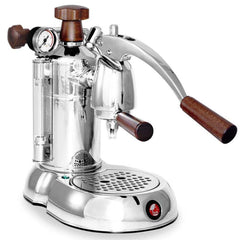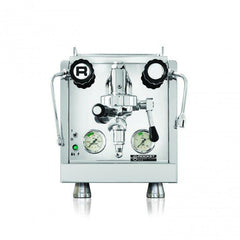
Selecting the right espresso machine can be a tall order for rookies and experts alike. Purchasing your own espresso machine is more commitment, and before you commit, we recommend that you first learn which type of machine best suits your preference, level of skill, and budget.
What exactly do you want? Which espresso machine would give you more bang for your buck? These are just a couple of questions that you would come across as you go through the buying process.

To walk you through it, let’s first jump right into the different types of espresso machines. There are four main classifications available: manual, semi-automatic, fully-automatic, and super-automatic. Learning the features of each type is important in ensuring you make an informed purchase.
Much like a restored car from early 1900s, manual machines exude a similar old-world appeal and style. These units don’t possess the crank start mechanisms that are present in the advanced models on today’s market. Instead, you’ll be dealing with the use of a lever, which comes in either spring piston lever or direct lever design. Of these two types, the latter requires greater effort. Another distinctive trait of manual espresso machines is they don’t hold constant water pressure on their own. This requires the user to manually push water through the coffee, which largely affects the quality of the finished product.
Manual machines are designed for hands-on coffee purists who are willing to invest the time and effort to master the craft of exquisite espresso brewing. Manual espresso makers let you control each step of the process, so you can painstakingly modify your shot to your liking. Pulling the perfect espresso shot takes practice and willingness, but can be a truly rewarding experience. My Espresso Shop recommends that these machines should be only be considered by beginners if they’ve done their research. Also note that manual espresso machines can be costly, but can last a lifetime with adequate care and maintenance.

Semi-auto espresso machines balance the extent of control that you get from manual espresso makers as well as the ease of use that automatic units boast. Built on Achilles Gaggia’s 1938 patent, semi-automatic machines were borne upon the introduction of electric pumps to practical devices. This breakthrough patent led to the technology behind hands-free water pressure. With this type of espresso maker, boiler temperature mechanisms are automated and users can easily switch the pump on and off. These added features immediately make semi-auto machines much easier to use than manual models. Categorically, semi-automatic espresso makers are the most popular type of machine in use today.
Another attractive characteristic of semi-auto machines is its wide range of brewing flexibility. You can use any type of coffee, ground coffee volume, adjust the grind fineness, and tamp pressure to create your ideal espresso shot. Most of these espresso makers don’t have circuit boards, or any complex internal controls. The mechanisms of semi-auto espresso makers can be navigated intuitively on a certain degree. Combine practice and good coffee and you’ll get high-quality, flavorful espresso shots with this one.
Fully-automatic espresso makers are a lot like their semi-automatic counterparts, except easier to operate. These machines typically include an electronic pump as well as controls that automate the amount and delivery of water passing through the espresso. Because fully-auto models are built with simpler mechanisms, this translates to less control for the user. This can only be an issue if you are very particular about how you like your coffee.
The price range of this model greatly varies. You can grab one for a few hundred bucks, or if you have more to spare—several thousands. Keep in mind that with fully-auto machines, there are more electronics, which means more functionalities are prone to breakage.
Super-automatic machines, with the name that it carries, take care of the entire espresso making process with one simple push of a button. These cutting-edge machines are equipped with a grinding apparatus and other brewing mechanisms that readily transforms the bean into a shot within a couple of minutes. They automatically grind the coffee, fill the filter basket, brew a preset amount of espresso, and then deposit the used coffee grounds into a built-in waste receptacle. An added functionality of this model is it can froth milk using a steam wand or an automated milk frothing system for preparing cappuccinos and lattes. With its array of bells and whistles, super-automatic units tend to be more pricey than other models.
Super-auto espresso makers are the absolute antithesis of manual machines. They are the easiest to use, and do not require any level of skill or practice. You only need to supply coffee beans, fill it up with water, then press a button. It is as quick and simple as it sounds. This model is ideal for those who drink multiple cups of coffee in a day and aren’t too concerned with intricately crafting the flavor of their espresso.
Ease of use is what most users might look for in an espresso machine. This depends on how much of the machine is automated as well as your level of espresso making expertise. For beginners, a manual machine may not be the best choice because it lacks the mechanisms that make it generally easy to operate. On the other hand, professional baristas can still find ease of use in manual espresso makers because of their high level of skill and technique. A good rule of thumb is to make sure that all the features and buttons are intuitive enough for you before buying.
The quality of build primarily dictates the lifespan of the machine. Espresso makers that are built with more durable materials tend to last longer. A machine predominantly made of metal is likely to outlast a plastic-bodied unit. Likewise, a model with more electric parts might have to undergo more repairs than its manual counterpart. Brand reputation and price points also come into play when it comes to determining the machine’s quality of build.
Since espresso machines vary in features and specifications, there is a wide price range that you can select from. A higher price often means better quality of materials and greater durability. With largely automated machines, higher end models likely have more built-in features and are easier to use.
We recommend that you invest in high-priced espresso machines if you are considerably discerning about the quality of your espresso or the amount of time it takes to make one. But if you aren’t very particular with either of those things and are content with any caffeinated beverage, a lower end model would be a more practical choice.
If you are still uncertain on which type to get at this point, perhaps you can look into simpler espresso machines first and go from there. But with any kind of espresso maker you select, you can be sure that you’ll be able to brew your own handcrafted beverage at the comfort of your own home, just the way you want it. And the fact that a homemade cup costs much less than going out to a neighborhood café should count as a plus for your long-term savings.
Start browsing through our vast selection of high-quality espresso machines!